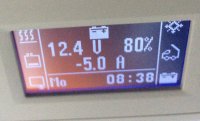Good morning,
I had a another look at the manual yesterday evening (bed time reading

).
I fell into some assumptions because I could not remember what I have read in the manual when I got the van.
The little van / car symbol
I assumed that the display is only about the batteries. I was wrong. The display will always show various information at the same time. The little van / car symbol is for the roof.
Battery symbol
This symbol has three different options:
- Battery charging level
- G - charged by the engine during driving (checked this morning)
- Symbol of a plug if hooked up (So far I have not connected the van to the power)
Charging display (Volt?)
According to the manual it is for the leisure batteries (both)
But with the rest I am still confused a wee bit, especially when I read Kmann comment. Driving the van and display shows 100% (which always does after driving) does not reflect the real charging level of the batteries and because of this it should be hooked up to fully charge.
So the information on the display is wrong. At what level should I be concerned that the charging level is not ok any more? To keep this information monitored is vital because relying on the available electricity of the van is important if one is of the grid for 2 or 3 days.
Maybe I over complicate things a bit.
Eberhard

















